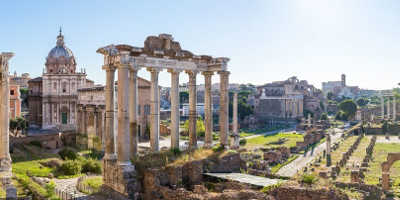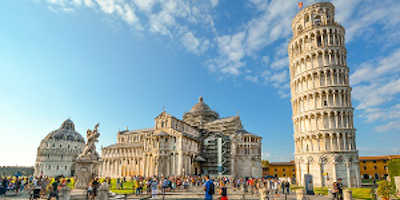What is the Pantheon?
Famed for its size, history and architecture, the Pantheon is one of the best preserved monuments of ancient Rome, situated in the Piazza della Rotonda.
The breathtaking Pantheon, more than 2000 years old, is one of Rome’s most famous buildings. It is the most well preserved Ancient Roman monument in all of Rome. Famous for its striking architecture, with its iconic pillars and enormous dome, people are usually happy enough to simply gaze at its grandeur than question its history. Named in Greek, which translates to “honour to all Gods,” this landmark is well worth stopping by at.
Origins
Despite its fame, there is a lot of mystery surrounding the Pantheon’s beginnings. Due to a lack of written records scholars have been unable to discover who designed the temple and how long the construction took. What we can decipher, however, is roughly when the build took place. Using our current knowledge of ancient Rome, scholars have estimated that the structure was completed around 126-128 A.D., during the reign of Emperor Hadrian. Saying that, other discoveries show that the construction of the Pantheon and it’s use are not that simple. Remember, these are events that took place over 2000 years ago, a lot has happened in that time and the building is still standing. It didn’t help that for some unknown reason Hadrian included Agrippa’s original inscription on the rebuilt Pantheon, reading “Marcus Agrippa the son of Lucius, three times consul, made this”, causing much confusion over its origins. Today, the Pantheon functions as a church, with catholic mass regularly held there, as well as being a major tourist attraction. Whatever it was in the path, its iconic pillars and unique design has influenced countless buildings throughout history, across Europe and the Americas.
The Making of the Pantheon
The exact date of the Pantheon is a mystery. Legend says that the original Pantheon was built on the very site where Romulus ascended to heaven. Some historians claim that Emperor Augustus’s right-hand man, Marcus Agrippa, was the first to build the Pantheon in 27 BC, which burned to the ground in 80 AD. Emperor Domitian rebuilt the building, but it was then struck by lightning and burned again in 110 AD. Finally, Emperor Hadrian commissioned Apollodorus of Damascus, a famous Greek architect, to rebuild this building once again in 120 AD. This Pantheon remained standing, now almost 2000 years old. Unfortunately, due to the conflicting opinions of Hadrian and Apollodorus over the design, the emperor had the architect executed and continued with his own vision. An interesting thing about this building is that the exact composition of materials is still unknown. However, a clue shows it was made with a mixture that is similar to modern-day concrete, which means the construction methods were ahead of their time.
The Pantheon’s Uses
The building’s inscriptions, whilst causing confusion in some cases, has also been useful in finding out what the Pantheon was built for. What was the purpose of its construction? And how has it been used over the years? Well, carved into the building’s concrete-like foundations are the Greek words pan theos, meaning “all gods”. Historian’s have interpreted this to mean that the Pantheon was built as a temple for the Roman Gods, a common belief held at the time. These Gods played a significant part in Roman society, so it is no surprise that the Emperor would embark on such an ambitious build considering the intended audience. Saying that, this purpose is only a guess as to why the Pantheon was built and what is was used for, other suggestions have also been put forward. Documents and records have also shown that Hadrian sometimes used the Pantheon as a place to hold court. But again to make it clear, no one knows the original purpose of the Pantheon, we can only make an educated guess. It’s late uses, however, can be said with some certainty. In 609 AD Pope Boniface IV got permission from Byzantine emperor Phocas to convert the Pantheon into a Christian church, known as Sancta Maria ad Martyres (St. Mary and the Martyrs). This was the first Roman pagan temple to be consecrated as a Christian church. This was made possible by the collapse of the Roman Empire and the introduction of Christianity, which spread from Western Asia and Europe into Rome.
The Dome of the Pantheon
When visiting the Pantheon, cast your eyes upwards to the magnificent dome above your head. Known as the eye of the pantheon, the dome is the largest unsupported dome in the world. Made from bricks and concrete, the Pantheon consists of three sections: a portico with granite columns, a massive dome, and a rectangular area connecting the other two sections. It stretches 43.30 meters and is in perfect proportion with the building by the fact that the distance from the floor to the top of the dome is exactly equal to its diameter. The oculus (opening) that sits at the top of the dome, allows sun-light (as well as other weather conditions) to shine through into the Pantheon. This illuminates the dome above and the room below in an incredible light – a unique, and inspiring experience for any traveller. If this wasn’t enough, the walls and floor of the circular interior are decorated with marble and gold detailing, creating a stunning display of light and warmth. This is bound to have an impression on anyone! Even Michelangelo said it was the design of angels, not man. As a result of its artistically beautiful interior and exterior architecture, the Pantheon has proved to be an important influence on great Renaissance architects, such as Andrea Palladio and countless others, its design spreading across Europe and beyond.















